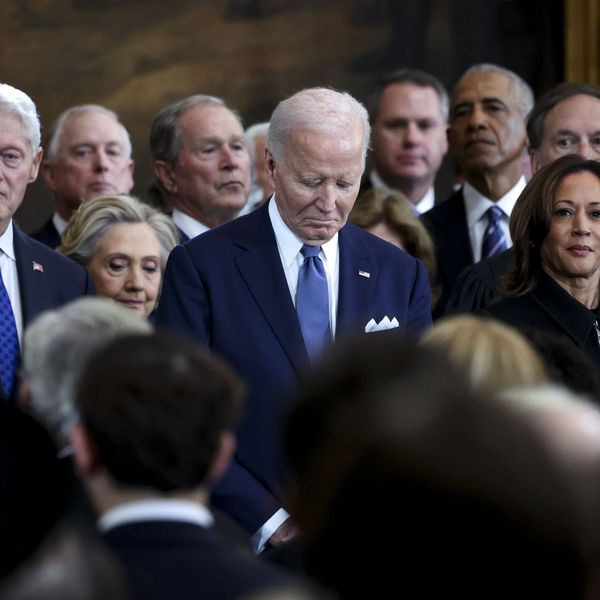(c)Michael Kamber: Latifiyah, Iraq. May 19, 2007.
What you're looking at, I'm afraid, is a potentially historic image.
Specifically, the photo above -- taken by embedded photojournalist Michael Kamber two weeks ago during a fateful patrol in search of missing American soldiers -- could well become the last visual evidence of U.S. casualties in the Iraq war.
In a message to colleagues earlier this week, Michael shared his personal thoughts about the new military restrictions on photographing American wounded in Iraq. He writes from Baghdad:
The embed restrictions have tightened up considerably since I was last here. You now need written permission from a wounded soldier to publish his photo if he is in any way identifiable. and even if his face is not visible. If unit insignias or faces of others soldiers are visible, that also disqualifies a photo from being used, according to one of the highest-ranking PAO's [Public Affairs Officer] in Iraq. As I'm told, the wounded man's family can figure out who he is from the other people in the picture.
I was on an operation last week that suffered five casualties including one KIA. One soldier was temporarily blinded and put on a plane to germany. Should I have asked him to sign a piece of paper giving permission to use pictures he can't see as he's lying on a stretcher in great pain?
When I was here in '03 and '04, the military was much more welcoming. I was invited to shoot memorials (now off limits) and when I embedded with the 1st Cav, they just invited me out. No papers to sign, no written conditions. They just asked that I show respect for the soldiers if they were killed, which I would do anyway.
Now there all these new restrictions make it nearly impossible to shoot the dead and wounded. They say it is for the soldiers protection. but the soldiers in the unit I was with -- the one that took the casualties -- loved our story and photos, thanked me and asked me for copies. The grandfather of the most seriously wounded soldier recently tracked me down demanding copies and saying the photos were crucial to his grandson's recovery.
I seriously question who these restrictions are for.
One journalist asked whether being wounded takes away your right to privacy. Actually, it does in my opinion. You're involved in a very public event, the largest war for the US since Vietnam. When you enlist and go into a war zone with journalists around, with historical consequences, you can not then claim that what happens is a private affair.
The question I pose is: What would have happened to our visual history if Robert Capa and Gene Smith were running around the battlefield during WWII trying to get releases signed as they worked? What if this had been required in Vietnam? Or any war?
Michael's slideshow for the NY Times, also based on this mission, is available here.
For more of the visual, visit BAGnewsNotes.com.
(c) 2007 Huffington Post
An Urgent Message From Our Co-Founder
Dear Common Dreams reader, The U.S. is on a fast track to authoritarianism like nothing I've ever seen. Meanwhile, corporate news outlets are utterly capitulating to Trump, twisting their coverage to avoid drawing his ire while lining up to stuff cash in his pockets. That's why I believe that Common Dreams is doing the best and most consequential reporting that we've ever done. Our small but mighty team is a progressive reporting powerhouse, covering the news every day that the corporate media never will. Our mission has always been simple: To inform. To inspire. And to ignite change for the common good. Now here's the key piece that I want all our readers to understand: None of this would be possible without your financial support. That's not just some fundraising cliche. It's the absolute and literal truth. We don't accept corporate advertising and never will. We don't have a paywall because we don't think people should be blocked from critical news based on their ability to pay. Everything we do is funded by the donations of readers like you. Will you donate now to help power the nonprofit, independent reporting of Common Dreams? Thank you for being a vital member of our community. Together, we can keep independent journalism alive when it’s needed most. - Craig Brown, Co-founder |
(c)Michael Kamber: Latifiyah, Iraq. May 19, 2007.
What you're looking at, I'm afraid, is a potentially historic image.
Specifically, the photo above -- taken by embedded photojournalist Michael Kamber two weeks ago during a fateful patrol in search of missing American soldiers -- could well become the last visual evidence of U.S. casualties in the Iraq war.
In a message to colleagues earlier this week, Michael shared his personal thoughts about the new military restrictions on photographing American wounded in Iraq. He writes from Baghdad:
The embed restrictions have tightened up considerably since I was last here. You now need written permission from a wounded soldier to publish his photo if he is in any way identifiable. and even if his face is not visible. If unit insignias or faces of others soldiers are visible, that also disqualifies a photo from being used, according to one of the highest-ranking PAO's [Public Affairs Officer] in Iraq. As I'm told, the wounded man's family can figure out who he is from the other people in the picture.
I was on an operation last week that suffered five casualties including one KIA. One soldier was temporarily blinded and put on a plane to germany. Should I have asked him to sign a piece of paper giving permission to use pictures he can't see as he's lying on a stretcher in great pain?
When I was here in '03 and '04, the military was much more welcoming. I was invited to shoot memorials (now off limits) and when I embedded with the 1st Cav, they just invited me out. No papers to sign, no written conditions. They just asked that I show respect for the soldiers if they were killed, which I would do anyway.
Now there all these new restrictions make it nearly impossible to shoot the dead and wounded. They say it is for the soldiers protection. but the soldiers in the unit I was with -- the one that took the casualties -- loved our story and photos, thanked me and asked me for copies. The grandfather of the most seriously wounded soldier recently tracked me down demanding copies and saying the photos were crucial to his grandson's recovery.
I seriously question who these restrictions are for.
One journalist asked whether being wounded takes away your right to privacy. Actually, it does in my opinion. You're involved in a very public event, the largest war for the US since Vietnam. When you enlist and go into a war zone with journalists around, with historical consequences, you can not then claim that what happens is a private affair.
The question I pose is: What would have happened to our visual history if Robert Capa and Gene Smith were running around the battlefield during WWII trying to get releases signed as they worked? What if this had been required in Vietnam? Or any war?
Michael's slideshow for the NY Times, also based on this mission, is available here.
For more of the visual, visit BAGnewsNotes.com.
(c) 2007 Huffington Post
(c)Michael Kamber: Latifiyah, Iraq. May 19, 2007.
What you're looking at, I'm afraid, is a potentially historic image.
Specifically, the photo above -- taken by embedded photojournalist Michael Kamber two weeks ago during a fateful patrol in search of missing American soldiers -- could well become the last visual evidence of U.S. casualties in the Iraq war.
In a message to colleagues earlier this week, Michael shared his personal thoughts about the new military restrictions on photographing American wounded in Iraq. He writes from Baghdad:
The embed restrictions have tightened up considerably since I was last here. You now need written permission from a wounded soldier to publish his photo if he is in any way identifiable. and even if his face is not visible. If unit insignias or faces of others soldiers are visible, that also disqualifies a photo from being used, according to one of the highest-ranking PAO's [Public Affairs Officer] in Iraq. As I'm told, the wounded man's family can figure out who he is from the other people in the picture.
I was on an operation last week that suffered five casualties including one KIA. One soldier was temporarily blinded and put on a plane to germany. Should I have asked him to sign a piece of paper giving permission to use pictures he can't see as he's lying on a stretcher in great pain?
When I was here in '03 and '04, the military was much more welcoming. I was invited to shoot memorials (now off limits) and when I embedded with the 1st Cav, they just invited me out. No papers to sign, no written conditions. They just asked that I show respect for the soldiers if they were killed, which I would do anyway.
Now there all these new restrictions make it nearly impossible to shoot the dead and wounded. They say it is for the soldiers protection. but the soldiers in the unit I was with -- the one that took the casualties -- loved our story and photos, thanked me and asked me for copies. The grandfather of the most seriously wounded soldier recently tracked me down demanding copies and saying the photos were crucial to his grandson's recovery.
I seriously question who these restrictions are for.
One journalist asked whether being wounded takes away your right to privacy. Actually, it does in my opinion. You're involved in a very public event, the largest war for the US since Vietnam. When you enlist and go into a war zone with journalists around, with historical consequences, you can not then claim that what happens is a private affair.
The question I pose is: What would have happened to our visual history if Robert Capa and Gene Smith were running around the battlefield during WWII trying to get releases signed as they worked? What if this had been required in Vietnam? Or any war?
Michael's slideshow for the NY Times, also based on this mission, is available here.
For more of the visual, visit BAGnewsNotes.com.
(c) 2007 Huffington Post


